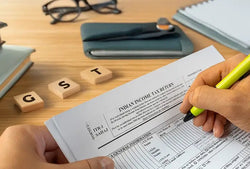However good your current income is, it can’t secure your future life unless you give savings a priority. Effective personal tax planning reduces your tax burden and multiplies your savings and investments.
Whatever may be your profession, if your annual income crosses the threshold value set by the government, you have to pay tax on the taxable amount. But the best thing is the government gives you opportunities to reduce the payable amount through sensible tax planning.
We are aware of this proverb – a penny saved is a penny earned. But a good tax planning guide actually gives back more value for each penny saved, through investing them in a variety of assured financial instruments that offer tax rebates under various sections.
What is tax planning?
The goal of tax planning is to ensure that all elements of your financial situation or plan work together to allow you to pay the lowest taxes possible. It is called tax-efficient planning when it minimizes the amount of tax you pay.
The tax planning process is an essential part of the financial plan of any individual investor. It is crucial for success to reduce tax liabilities and maximize retirement plan contributions.
Tax planning checklist
Your personal tax planning guide should be a comprehensive one to ensure minimum tax output and ample wealth creation. Here is a 3-point checklist to identify the right investment avenues for your tax planning in 2023 :
- The first step in tax planning should be to figure out how much tax you’ve already saved. This is significant because our everyday expenses, such as money spent on a child’s education, life insurance, health insurance, or purchasing a home, have tax implications. We must thoroughly examine them.
- The second step should be to determine how much additional investment you have to make to avail of the deduction of 20% for income up to Rs.1.5 Lakh provided under 80C. Knowing the amount of tax you’ve already saved allows you to push even harder to exhaust the 80C rebate.
- The third step is to seek out a good investment opportunity. While doing so, you must first determine your life goals and risk tolerance.
income tax slab rates for the fiscal year 2022-23 (new tax regime)
| S. No. | Income slabs | Income tax rate |
| 1 | Up to Rs 2.5 lakh | Nil |
| 2 | Between Rs 2,50,001 and Rs 5 lakh | 5 percent |
| 3 | Between Rs 5,00,001 and Rs 7.5 lakh | 10 percent |
| 4 | Between Rs 7,50,001 and Rs 10 lakh | 15 percent |
| 5 | Between Rs 10,00,001 and Rs 12.5 lakh | 20 percent |
| 6 | Between Rs 12,50,001and Rs 15 lakh | 25 percent |
| 7 | Above Rs 15 lakh | 30 percent |
For the fiscal year 2022-23, taxpayers will be able to choose between the new tax regime and the old tax regime, as they have in the previous two years. The tax slab under the new tax regime will be the same for all categories of individuals and HUFs up to the age of 60, senior citizens over the age of 60 up to the age of 80, and super senior citizens over the age of 80.
Sections 80C, 80D, and 80E of the Income Tax Act are the most commonly used for tax-saving purposes. Section 80C allows for the deduction of popular instruments such as EPF, ELSS, ULIP, and NPS. However, deductions under Section 80C are limited to Rs.1.5 lakh. Sections 80D and 80E have similar savings and investment avenues and limits.
H2 Ways to Save Taxes Under Sections 80C, 80D, and 80E
Make a Rs 1.5 lakh investment under Sec 80C to reduce your taxable income. Investing in NPS under 80CCD allows for an additional deduction of Rs 50,000. (1b)
Under Section 80D, the maximum deduction allowed is Rs. 1,00,000 (Rs 50,000 for self and family if senior citizen and Rs 50,000 for senior citizen parents).
Section 80EE allows you to deduct up to Rs 50,000 in home loan interest. You can also save tax on higher education loans for yourself, your spouse, children, or legal wards.
A nil ITR is better than no ITR
Individuals who earn less than the taxable income level should file a nil income tax return. Tax professionals advise filing a nil ITR because one cannot claim a refund on tax deducted at source (TDS) unless they file an income tax return.
Filing IT returns serves as proof of income when applying for a visa or passport and can help you obtain various financial products or services such as loans. As a result, even if your annual income is less than Rs 2.5 lakh, you must file an income tax return to qualify for the benefits.
There are approximately seven Income Tax Return (ITR) forms available for various categories of taxpayers to file before the end of a fiscal year. The ITR-1 (Sahaj) form is one of the simplest and is used by a large number of individual taxpayers.
Sahaj is required to be filed by taxpayers with income up to Rs 50 lakh from salary, one house property, or other sources (interest, etc.). If your income exceeds Rs 50 lakh or you want to claim expenses under the category ‘Income from Other Sources,’ you must use the ITR-2 form.
Before you begin filing your ITR returns online, calculate your total income for the fiscal year 2022-2023. You can do this by filling out the Form-16 that your employer gave you. Form -16 can assist you in determining your total income as well as the amount of taxes deducted at the source. If you have other sources of income, such as house rent or capital gains, you must calculate it before filing your IT returns.



